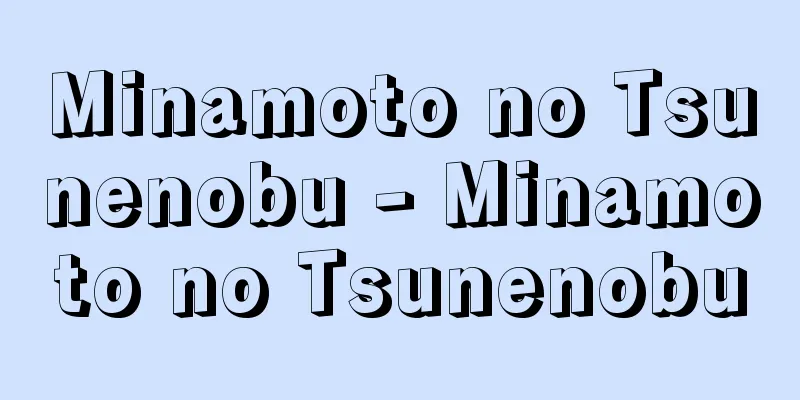Minamoto no Tsunenobu - Minamoto no Tsunenobu

|
A poet and Chinese poet of the Heian period. He was the sixth son of Michikata, Minister of Civil Affairs (Senior Second Rank), and his mother was the daughter of MINAMOTO no Kunimori, Governor of Harima, and was also a poet. He was the father of the poet Toshiyori. He served the Six Dynasties as a court official, and in 1094 (Kaho 1), he was made Dainagon (Senior Second Rank) and Dazai Gon no Sochi (Commander of the Dazai), but he died in his post on the 6th of the first month of the leap year of 1097 (Shotoku 1). He was 82 years old. His "Jikkinsho" and "Kokonchomonju" praise Sansen's talents (poetry, songs, and instrumental music). In poetry, he left 25 poems in "Honcho Mudai Shi" and "Chuu-u-ki Burui-shi-hi Kanshishu", four essays in "Honcho Zoku Monzui", "Chono Gunzai" and "Honcho Bunshu", and a family journal "Sokki", while in waka, he left 85 poems in the imperial anthologies starting with "Goshuishu", a family anthology "Dainagon Tsuneshinshu", and wrote "Nangoshuishu", which criticized "Goshuishu". He is noted in the history of waka as a poet who perfected the theory and technique of medieval hare no uta (court poetry) by inheriting the ideas and methods of Fujiwara no Kinto, Noin Hoshi, and the poets of the Waka Rokuninto. [Ueno Osamu] "Ueno Osamu's 'Before and After the Goshuishū' (1976, Kasama Shoin)" ▽ "Kinhara Hara's 'Minamoto no Tsuneshin' (included in 'Medieval Literature and Chinese Literature II', 1987, Kiko Shoin)" <Upper verse> When evening comes, the rice leaves of the gate fields come to me <Lower verse> An autumn wind blows through the round reed hut. Fixed characters (fixed characters): Characters (sounds) that specify the poem / Yufu Minamoto no Tsunenobu (Dainagon Tsunenobu) Hishikawa Moronobu illustrations [and others] Ogura Hyakunin Isshu 1680 (Enpo 8) National Diet Library possession Ogura Hyakunin Isshu (71) Poet/Minamoto no Tsunenobu (Great… Source: Shogakukan Encyclopedia Nipponica About Encyclopedia Nipponica Information | Legend |
|
平安時代の歌人、漢詩人。正二位民部卿(きょう)道方の六男、母は播磨守(はりまのかみ)源国盛の女(むすめ)で歌人。歌人俊頼(としより)の父。廷臣として六朝に仕え、1094年(嘉保1)正(しょう)二位大納言(だいなごん)に大宰権帥(だざいのごんのそち)を兼ねたが、1097年(承徳1)閏(うるう)正月6日任地に没した。82歳。『十訓抄(じっきんしょう)』『古今著聞集(ここんちょもんじゅう)』は、三船(さんせん)(詩、歌、管絃(かんげん))の才を賛美する。詩文は、『本朝無題詩』『中右記部類紙背漢詩集』に25首の詩、『本朝続文粋(もんずい)』『朝野群載』『本朝文集』に4編の文章、家記『帥記(そっき)』を残し、和歌は、『後拾遺集』以下の勅撰(ちょくせん)集に85首、家集『大納言経信集』を残し、『後拾遺集』を批判した『難後拾遺』を著す。藤原公任(きんとう)や能因(のういん)法師、和歌六人党の歌人たちの理念や方法を継承して、中世的な晴の歌(宮廷詩)の理論と詠法を完成させた歌人として和歌史上注目されている。 [上野 理] 『上野理著『後拾遺集前後』(1976・笠間書院)』▽『金原理著『源経信』(『中古文学と漢文学Ⅱ』所収・1987・汲古書院)』 〈上の句〉夕されば 門田の稲葉 おとづれて 〈下の句〉葦の丸屋に 秋風ぞ吹く ゆふさればかどたのいなばおとづれて あしのまろやにあきかぜぞふく定まり字(決まり字):歌を特定する字(音)/ゆふ源経信(大納言経信)菱川師宣画[他]『小倉百人一首』 1680年(延宝8)国立国会図書館所蔵"> 小倉百人一首(71) 歌人/源経信(大… 出典 小学館 日本大百科全書(ニッポニカ)日本大百科全書(ニッポニカ)について 情報 | 凡例 |
<<: Minamoto no Tsunemoto - The origin of Minamoto
Recommend
Marut
In particular, the existence of a mythology cente...
Aichukamibun - Aichukamibun
...He was in the shortest distance to be promoted...
Melanitis
...A general term for insects belonging to the Me...
Shammai (English spelling)
A leading Jewish legal scholar around the time of ...
Hypothesis - hypothesis (English spelling)
In scientific research, a proposition (or part of...
Asukaru - Asukaru
The canal was built in the 15th century by the Ph...
Ludwig, O. (English spelling) LudwigO
…German realist writer. His poetic realism, which...
Great funeral - Taisou
The funerals of Emperor Taiko (the title of the f...
Socialist Association - Shakaishugikyokai
A socialist research and practice group in the Me...
Lumped lava - kaijoyogan
A type of lava flow. It is made up of a collection...
Indifference theory
A position on epistemology in medieval philosophy....
Rabies - rabies
Once the disease develops, it attacks the central...
Sialkot
A city on the left bank of the Chenab River in nor...
Janibek Khan (English spelling)
… [Toru Horikawa]. … *Some of the terminology exp...
Kamihayakawa Village
...Itoigawa City occupies the area downstream of ...









